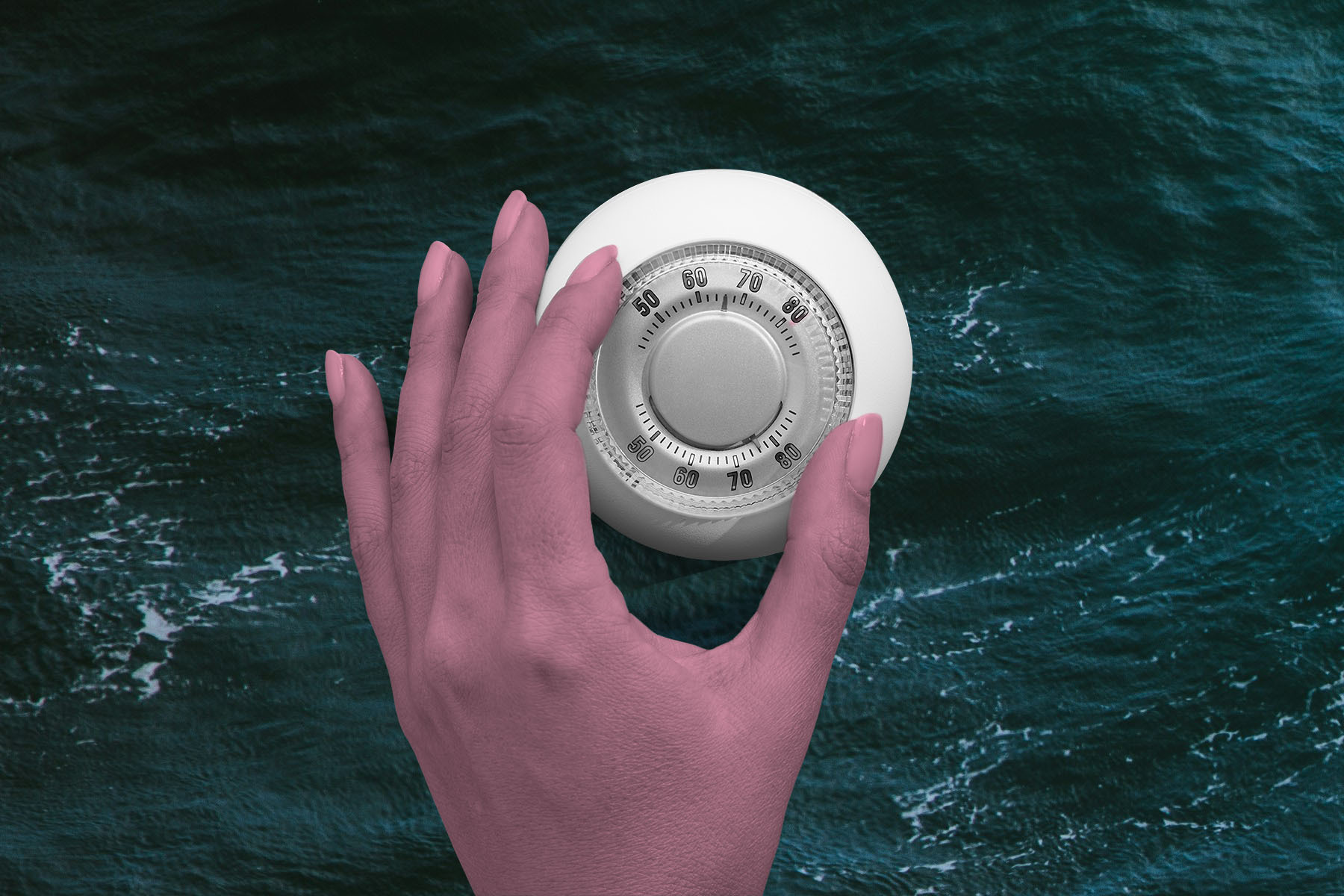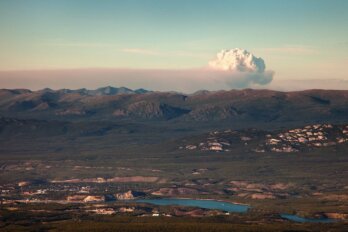I n early 2023, members of the Cornwall Marine Liaison Group gathered for a meeting about marine biodiversity featuring a presentation with the Canadian company Planetary Technologies. Over a video call, staff presented their plan to add magnesium hydroxide to the waters of St. Ives Bay, a picturesque crescent on England’s southwest peninsula, via a wastewater pipe. The company pitched the three-month trial as a safe form of carbon dioxide removal—an “antacid for the sea,” says Sue Sayer, founder and director of the Seal Research Trust, who was at the meeting. For the audience, most of whom were highly attuned to the risks of climate change, the idea seemed like something simple and safe.
Months later, though, concerns had surfaced. At a second meeting, this time with townspeople in nearby Hayle, audience members assailed the company with questions: Why St. Ives Bay? What about wildlife? Shortly after that, protesters gathered on a sloping hillside overlooking the bay, holding signs reading “Planetary can stick it up their waste pipe” and demanding more scientific oversight.
Planetary Technologies, based in Nova Scotia, has said that the proposed levels of magnesium hydroxide in the water would be far below that of a toxic dose for marine life; in 2024, an independent audit of the plan deemed it “very low” risk. Planetary also told the community they were committed to extensive monitoring before and after the trial, which was originally set for 2023 but has yet to receive the go-ahead from the UK’s Environment Agency.
But community members remain skeptical. “What we want is the proper due diligence to be done,” says Sayer, who is calling for more ecosystem monitoring, given the potential effects on the environment and the local tourism economy. “We can’t afford negative impacts here.”
The implications for this kind of technology have the potential to go far beyond St. Ives Bay.
To address climate change, there have been many policies and technologies to stop or slow down CO2 production. Carbon removal may provide an additional solution: it pulls the harmful gas from the atmosphere and compresses or liquefies it, storing it underground, where it is turned into physical carbon that can be safely and harmlessly stored.
Now, attention is turning to the ocean, which already absorbs roughly a quarter of our carbon emissions, thanks in part to carbon dioxide’s basic principle—CO2 concentrations in the air and water tend to stay balanced, and as atmospheric CO2 has increased, the ocean has been sucking up more of the gas too. Start-ups and research projects that aim to boost this ability are proliferating, built on the idea that if you add minerals or wood chips or CO2-sucking seaweed to the ocean, you will subtract carbon.
Start-up executives and scientists argue that time is running out to prevent a climate catastrophe, and that rapid progress on ocean carbon dioxide removal—which falls under the umbrella of marine geoengineering—is necessary to avert such an outcome.
Yet this technology is racing ahead of regulations or is being slated for areas where regulations are difficult to apply, like the high seas (the parts of the ocean beyond national borders). Some scientists worry that part of the momentum behind marine carbon removal relies on the idea of the ocean as a featureless space—or perhaps a blank cheque—rather than the complex, poorly understood system that it is in reality. Tinkering with this system may have consequences we can ill afford. But with the impacts of climate change increasingly certain, it may be that we can’t afford not to.
I n 2012, a flurry of emails, accessed through Freedom of Information requests, drifted between managers at Fisheries and Oceans Canada and Environment Canada. Seemingly nonplussed officials warned colleagues that a controversial California businessman named Russ George, along with the Haida Salmon Restoration Corporation (HSRC), was planning to dump iron dust in the international waters off Haida Gwaii. According to the emails obtained, George was promising to provide the Haida Nation with millions of dollars in revenue from selling carbon credits, along with the restoration of depleted salmon runs.
The basic premise—first proposed by oceanographer John Martin in 1990—was that adding iron to the water would nourish a bloom of tiny photosynthesizing organisms called phytoplankton. The fruits of this “ocean fertilization” would then sink to the ocean floor, taking the carbon dioxide they’d absorbed from the atmosphere with them, storing the carbon for centuries (and, in this case, supporting a new food source for fish).
But in emails, staff were skeptical. “As you know, all of this is very dubious, right from the science to the ability to actually obtain credits,” wrote one fisheries manager. More to the point, Environment Canada staff said they had warned the company that the dumping was illegal; it violated the terms of the London Convention/London Protocol, an international treaty on marine pollution which regulated dumping at sea, except for authorized experiments. The company did not have a permit, yet the project went ahead anyway; in July of 2012, HSRC spread roughly 100 tonnes of iron sulfate around 370 kilometres off the west coast of Canada.
Backlash was swift, with condemnation in the House of Commons and at the United Nations. Environment Canada investigated, though no charges were laid; parties to the London Protocol issued an amendment aimed at regulating marine geoengineering. Meanwhile, the 2013 salmon harvest hit record levels—though experts said this was hard to attribute to the experiment. The carbon benefits were inconclusive.
Over a decade later, some scientists’ frustration with the trial—and the subsequent backlash—is that it set progress on legitimate ocean carbon dioxide removal back by a decade. “[It was a] tremendous delay,” says Kate Moran, president and CEO of Ocean Networks Canada, a research facility with ocean observatories linked to the University of Victoria. “It wasn’t the research community that did this—it was a guy that just decided to do it.”
Then, in 2018, the Intergovernmental Panel on Climate Change made the stakes clear. In the report, the agency said there was no path to meeting the 1.5-degree-Celsius target of the Paris Agreement without active carbon removal—and a new industry was born.
The approaches in this industry vary widely—from tree planting to no-till farming to sucking carbon out of the air. Each one is a form of carbon removal. In the ocean, technologies follow two paths, and companies in Canada are investigating both.
One is to change the ocean’s chemistry. In the Atlantic, Planetary Technologies is investigating ocean alkalinity enhancement, where adding alkaline material to sea water converts dissolved CO2 into a stable form that floats in the ocean for thousands of years, allowing the ocean to then pull more carbon dioxide from the atmosphere—an approach that also has the benefit of reversing ocean acidification. In addition to the proposed trial in Cornwall, the company ran a small-scale test in the Halifax harbour in September (this time, there were no protests); data from that test is still being analyzed, but the company reported that initial results suggest the test successfully increased the water’s pH and there were no unanticipated ecosystem changes. Meanwhile, a carbon removal company called Deep Sky is working with two start-ups to build facilities to trial electrochemical approaches at a site on the north shore of the St. Lawrence River.
Another approach uses biological processes, via ocean fertilization or seaweed production, to uptake carbon. As Planetary Technologies was running a test in Halifax, US company Running Tide, in partnership with Ocean Networks Canada, was testing a biomass-based system off the coast of Vancouver Island. In Running Tide’s system, buoys made of forestry by-products—which would otherwise release carbon into the atmosphere as they decompose—are sunk into the deep ocean, where carbon can stay sequestered for centuries. (Technically, Running Tide’s is a hybrid approach, since they also coat the wood chips with alkaline material and propose seeding the buoys with seaweed, which absorbs CO2 as it grows.)
These are just a handful of the hundreds of companies that have sprung up to capture the ocean’s potential—and the multi-billion-dollar voluntary carbon offset market, where companies can compensate for the CO2 emitted by, say, running computer servers or operating transcontinental flights by purchasing a credit for an equal amount of CO2 reductions somewhere else—a proliferation that was on display at the most recent United Nations Climate Change Conference, COP 28.
Lisa Levin, marine ecologist at the Scripps Institution of Oceanography, University of California, San Diego, says academics and entrepreneurs at the conference extolled the potential of ocean carbon removal technologies. “I listened to session after session about these,” she says. “Nobody was talking about environmental risk.” In 2020, Levin and other experts, realizing the potential for effects in the deep ocean, started discussing marine carbon dioxide removal (CDR). Researchers found a range of possible consequences. Tonnes of seaweed or forestry waste dropped on the sea floor could smother life there; alkaline material spread on the surface could change the flow of light and ocean chemistry, affecting the larval stages of ocean critters; iron fertilization could exacerbate ocean acidification and deoxygenation by enhancing algal decay.
Levin says many of the pitches for marine carbon dioxide removal she’s encountered characterize the deep ocean as a featureless space; when she’s pointed out that there is life on the sea floor, “the comment I usually get back is, ‘Well, we’re gonna have to make trade-offs. We’re going to have to decide what’s more important.’” But determining the terms of those trade-offs is difficult, she says, which is why some researchers say it’s important for scientists to assess these technologies.
In 2023, a research consortium led by Dalhousie University received $15 million in funding from the Carbon to Sea Initiative to study ocean alkalinity enhancement. While the initiative bills alkalinity enhancement as one of the most promising CDR approaches, the consortium’s lead investigator, Dalhousie oceanography professor Katja Fennel, is circumspect. The most important action remains reducing greenhouse gas emissions, she says—but the lack of progress on doing so has made it necessary to investigate marine carbon dioxide removal. “That realization is happening to geoscientists who maybe five to ten years ago would have not even touched this. That certainly is what happened with me,” she says. “We can’t afford to squander precious time here and say, ‘We’ll figure it out in ten years.’”
The consortium is scrutinizing the biological impacts, the scalability and feasibility, and the monitoring, reporting, and verification involved in tweaking the ocean’s alkalinity—all of which need to be investigated to determine whether alkalinity enhancement harms ecosystems and to quantify how much carbon it actually removes from the atmosphere.
Fennel recognizes the moral hazard in carbon removal, in that it could offer an excuse to continue emitting. But there’s a risk in sitting out this moment too. Much of the interest in carbon removal is already driven by private interests—many carbon removal start-ups, including those operating in Canada, are funded in part by the sale of carbon offsets. Running Tide, for instance, has reportedly sold credits to Shopify and Microsoft. This is why researchers—like Fennel or David Ho, professor in the department of oceanography at the University of Hawai`i at Mānoa and a co-founder of a non-profit research organization focused on marine carbon removal—say scientists need to provide an independent assessment of the technologies’ effects and efficacy; without that, Ho says, the promised carbon removal amounts to greenwashing. “The verification step has to be non-profit, and it has to be separate from your money-making scheme,” says Ho, who co-founded [C]Worthy, a nonprofit that makes open-source software to quantify the efficacy and side effects of marine carbon removal. “As ocean biogeochemists, if we have the inclination and we have the skills, then it behooves us to work on it.” For Fennel, too, this imperative exists; already, she says, scientists are struggling to keep pace with private money. But government regulators are even farther behind.
In Canada and internationally, there are no specific regulations that deal with marine carbon dioxide removal, says Neil Craik, professor of international law at the University of Waterloo. While the 2013 amendment to the London Protocol introduced after the Russ George debacle could provide a framework, it has not been ratified by enough parties to be legally binding, with Canada among the laggards. Either way, it currently covers only ocean fertilization (though the London Protocol Parties issued a statement in 2023 raising concerns with the potential “deleterious effects” of other marine geoengineering techniques).
In a statement, Natural Resources Canada said a legislative and regulatory framework to assess and, if appropriate, authorize and regulate marine carbon dioxide removal is under way. The statement also said the government is working toward implementing international agreements, including the London Protocol, aimed at ensuring the safe implementation of emerging technologies. In the meantime, Craik says the regulatory gap carries real risk. As the need for carbon removal grows, it may be difficult to carry out enough of it on land, making the ocean look, as ever, like an easier dumping ground. “Canada needs to be very clear about the need to have a strong regulatory set of mechanisms in place proactively, to ensure that particularly the high seas, but I think the oceans generally, don’t all of a sudden become an unregulated frontier.”
But regulations move slowly, and Kate Moran, of Ocean Networks Canada, says that international agreements have made it clear that research on carbon dioxide removal needs to advance as fast as possible. “I think people across the board understand that a process has to be followed, but that it can be accelerated without too much impact, just because of the urgency,” says Moran. “I think that’s where we are.”
This is indeed where we are, at this hour of the climate crisis. Marine carbon dioxide removal, especially at the planetary scale, is tinkering with one of the planet’s most complex systems. But climate change is doing that too, and those side effects are manifold: ghostly coral reefs, collapsing currents, supercharged hurricanes, spiking water temperatures. Whether interventions are deliberate or not, there’s no way back to a time where human fingerprints aren’t stamped all over the outcome. Deciding which fingerprints we’re willing to accept is the question.
Correction, June 10, 2024: An earlier version of this article stated that carbon capture pulls harmful gas from the atmosphere and stores it. In fact, this is the process of carbon removal; carbon capture collects CO2 at the source of emission. The Walrus regrets the error.






